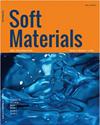Simulation of magneto-mechanical response of ferrogel samples with various polymer structure
IF 1.4
4区 材料科学
Q4 MATERIALS SCIENCE, MULTIDISCIPLINARY
引用次数: 1
Abstract
ABSTRACT Following the coarse-grained molecular dynamics approach, we propose a model of a small ferrogel sample (containing up to 1000 magnetic nanoparticles), in which the polymer matrix is presented in the form of a quasi-regular mesh of spring-beads chains and the filler particles are located at the mesh nodes. The state of the sample in the absence of an external field and in the process of quasi-static magnetization is considered for two types of mesh topology (simple cubic and diamond-like), different values of the filler concentration, the strength of dipole interaction, and the energy of magnetic anisotropy. Simulation shows that the use of a softer matrix with a diamond-like structure increases the magneto-mechanical response of the ferrogel. The presence of magnetic anisotropy leads to effective hardening of the ferrogel and, thus, prevents particle clustering and sample magnetization. It was also found that the anisotropy energy determines the type of field-induced changes in the sample volume – this aspect of material behavior is important for the use of ferrogels in controlled delivery and/or release of drugs.不同聚合物结构铁凝胶样品的磁-力响应模拟
摘要根据粗粒度分子动力学方法,我们提出了一个小型铁凝胶样品(包含多达1000个磁性纳米颗粒)的模型,其中聚合物基体以弹簧珠链的准规则网格的形式呈现,填充颗粒位于网格节点处。对于两种类型的网格拓扑结构(简单立方体和类金刚石)、不同的填料浓度值、偶极相互作用强度和磁各向异性能量,考虑了在没有外部场和准静态磁化过程中样品的状态。模拟表明,使用具有类金刚石结构的较软基体可以提高铁凝胶的磁机械响应。磁各向异性的存在导致铁凝胶的有效硬化,从而防止颗粒聚集和样品磁化。还发现,各向异性能量决定了场诱导的样品体积变化的类型——材料行为的这一方面对于在药物的控制递送和/或释放中使用铁凝胶非常重要。
本文章由计算机程序翻译,如有差异,请以英文原文为准。
求助全文
约1分钟内获得全文
求助全文
来源期刊

Soft Materials
工程技术-材料科学:综合
CiteScore
2.90
自引率
0.00%
发文量
21
审稿时长
2.2 months
期刊介绍:
Providing a common forum for all soft matter scientists, Soft Materials covers theory, simulation, and experimental research in this rapidly expanding and interdisciplinary field. As soft materials are often at the heart of modern technologies, soft matter science has implications and applications in many areas ranging from biology to engineering.
Unlike many journals which focus primarily on individual classes of materials or particular applications, Soft Materials draw on all physical, chemical, materials science, and biological aspects of soft matter. Featured topics include polymers, biomacromolecules, colloids, membranes, Langmuir-Blodgett films, liquid crystals, granular matter, soft interfaces, complex fluids, surfactants, gels, nanomaterials, self-organization, supramolecular science, molecular recognition, soft glasses, amphiphiles, foams, and active matter.
Truly international in scope, Soft Materials contains original research, invited reviews, in-depth technical tutorials, and book reviews.
 求助内容:
求助内容: 应助结果提醒方式:
应助结果提醒方式:


